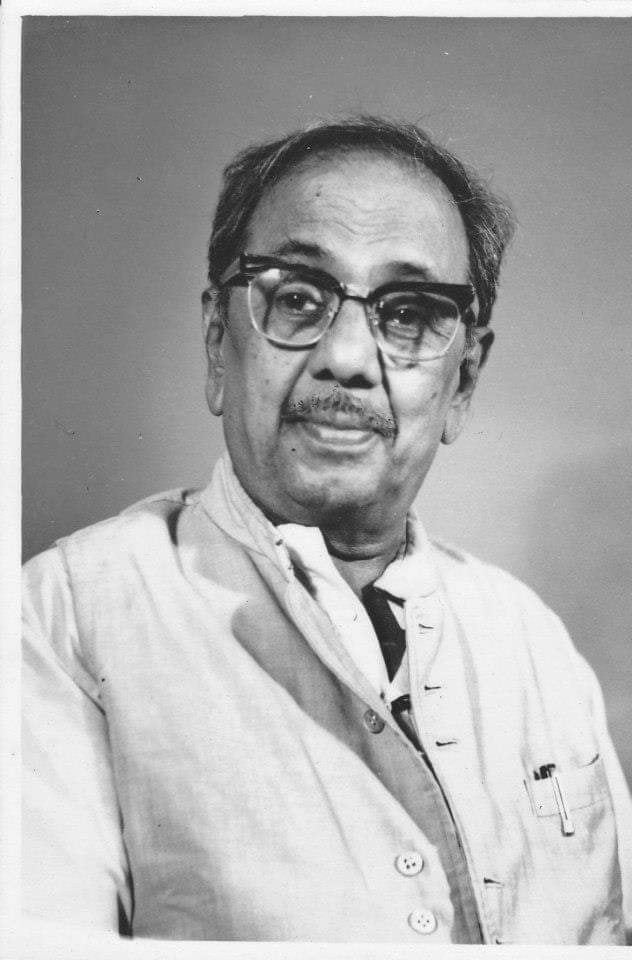Pandit Nivruttibua Sarnaik

The legendary vocalist and guru, Pandit Nivruttibua Sarnaik (4 July 1912 - 16 February 1994) was born in a small village of Kolhapur, Maharashtra. His father, Shri Tukarambua Sarnaik, was a well-known singer of bhajans of his time. When Nivrutiibua was five, his uncle, Shankarrao Sarnaik(father of the beloved Marathi actor Arun Sarnaik) took him under his wings and brought him to the Shivraj Natak Mandali, a drama company, which had been founded by the famous composer and harmonium wizard, Pt. Govindrao Tembe, and some others. After some years, the company’s ownership changed and it was renamed the Yashwant Natak Mandali.
Nivruttibua played various roles, including female ones, in many plays that the company used to perform. He also travelled extensively with the company. During all this time he used be around his uncle Shankarrao Sarnaik, who had become a disciple of the legendary Pt. Sawai Gandharva, a doyen of the Kirana gharana. Shankarrao was simultaneously learning from Pt. Govindrao Tembe. On his part, the young Nivruttibua was imbibing the gayaki of Shankarrao, who, in a sense, was his first guru. But his formal training started under Govindbua Bhave. Soon thereafter, Nivruttibua became a disciple of Pt. Sawai Gandharva and, subsequently, he got the opportunity to learn the Jaipur-Atrauli gayaki from Ustad Alladiya Khan himself, as also from Ustad Rajab Ali Khan. After Yashwant Sangeet Mandali closed in 1935, Nivruttibua came back to Kolhapur with his uncle’s family. He began grooming himself for classical singing through relentless riyaz.
In course of time, Nivruttibua evolved a distinctive style of his own, which was marked by an eclectic approach, constantly improvising, even while it maintained its moorings firmly in purism. It can be said that his gayaki was a blend or confluence of the Kirana and Jaipur-Atrauli gharanas. In addition, he was deeply influenced by Ustad Amir Khan, as he himself used to acknowledge. He became one of the most popular Hindustani vocalists of his time. As early as 1937, he performed so well at a concert at Shikarpur (now in Pakistan), that he was felicitated with a garland of 10-rupee currency notes, which had great value in those days.
All through his musical journey, Nivruttibua collected innumerable bandishes, or compositions, from many diverse people: apart from Ustad Alladiya Khan, he got bandishes from Ashiq Ali Khan, Hafiz Ali Khan(father of Amjad Ali Khan) and many others, from different gharanas, including Gwalior and Patiala, apart, of course, from Kirana and Jaipur-Atrauli.
An important fact to be noted is that Nivruttibua was also an excellent Tabla player. He had learnt to play the Tabla quite early, during his stint with the Natak Mandali. Initially, he learnt it from the tabla accompanists of the company, Rukdikar and Babalal Islampurkar. Afterwards, given his eclectic approach, he learnt the nuances of the Tabla from many distinguished visiting Tabla maestros, including the Grand Old Man of the Tabla, Ustad Ahmedjan Thirakwa, as also Ustad Natthu Khan. As a result, Nivruttibua had an exceptional understanding of taal, rhythm, and taan, a hallmark of the Jaipur-Atrauli gayaki.
He could strike the most appropriate balance between the two, which had a significant bearing on his unique style.
Nivruttibua came to Mumbai in 1966. Between 1969 and 1979, he was an Honorary Guru in the Music Department of Mumbai University. In 1979, Panditji was a senior guru in Sangeet Research Academy in Calcutta for 12 years. The SRA is an institution sponsored by ITC and dedicated to the pursuit of music as Guru-Shishya parampara. His teachings mainly included the Jaipur Gharana Gayaki. He had great knowledge of the "Anvat Ragas".
• Disciples : In Kolhapur, Late Pt. Sudhakarbua Digrajkar, Arun Kulkarni, Late Sardarbai Kardgekar, Appasaheb Deshpande, Late Smt. Varshraje Pandit, Mrs. Bharati Vaishampayan, Vinod Digrajkar and many others took the opportunity to learn Jaipur Gayaki and anvat ragas from Panditji. Today many of them are class one performers.
Needles to say he left behind a lot of disciples. His shishya Smt. Vijaya Jadhav Gatlewar, Pt. Dinkar Panshikar, late Pt. Prabhudev Sardar have made their grade on the concert platform.
Today's legends and all time popular vocalist such as Late Pt. Jitendra Abhisheki, GaanSaraswati Kishori Amonkar, Dr. Prabha Atre, Pt. Ulhas Khasalkar, Pt Arun Kashalkar and Mrs. Padma Talwalkar learn and took guidance from PanditJi for some time and got benefitted.
Several other disciples like Smt. Vandana Bhagwat, Prasad Gulvani, Smt. Chaya Rahalkar, Late Sri Ramesh Ganpule, Late Srikrishna Kastur, Smt. Vrinda Limaye, Dr. Lata Godse, Smt. Nilakshi Juvekar, Smt. Madhuri Oak, Smt. Nandini Rege, Shri. Madhusudan Aapte and many more are benefitted from his tutelage and guidance.
Tragically, Nivruttibua got Parkinson’s disease in 1991 and his health began to detoriate. He returned to Mumbai in 1991.
He passed away on 16 February 1994, at the age of 81, leaving behind a rich and lasting legacy.
On his Birth Anniversary, Hindustani Classical Music And Everything pays rich tributes to the legend and are very grateful for his contributions to the Indian Classical Music
लेख के प्रकार
- Log in to post comments
- 119 views
